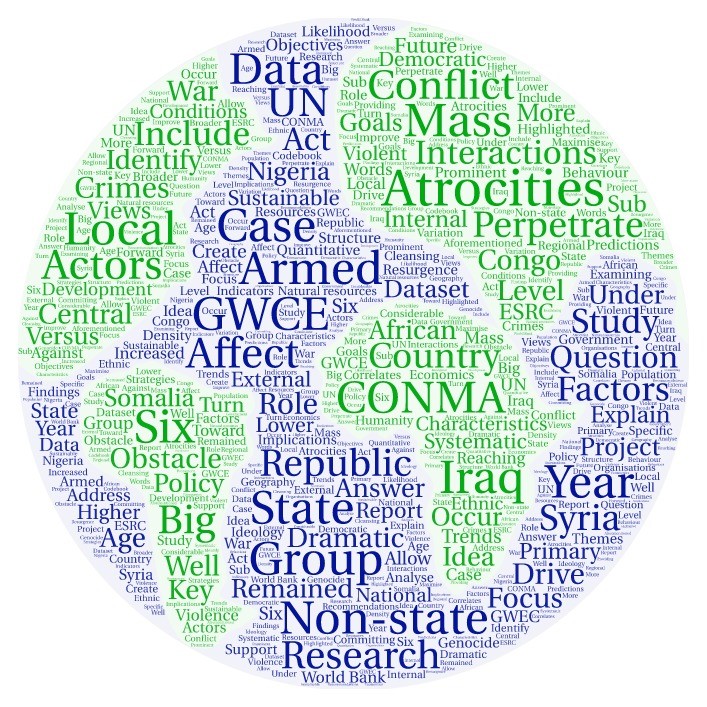Explaining Non-State Perpetration of Mass Atrocity Crimes

Dr Adrian Gallagher and Dr Kaisa Hinkkainen provide an overview of their @ESRC project 'Explaining Non-State Perpetration of Mass Atrocity Crimes'. They are looking to hire six research assistants, see link below.
As part of the European Centre for the Responsibility to Protect Fresh Perspectives blog series, we want to take this opportunity to provide an overview of an ESRC funded project that we start this month (January 2021), which will run until June 2023. We also include a link to the advertised posts as we seek to hire six research assistants for a period of twelve months starting in May 2020.
Context
In 2018, the UN and the World Bank highlighted the ‘dramatic resurgence’ of violent conflict since 2010 which it views as ‘one of the big obstacles to reaching the Sustainable Development Goals (SDGs) by 2030’. The report identifies three trends, i) state versus state conflict has remained at a lower level (between 0 and 5 conflicts per year), ii) state versus non-state conflict has remained at a higher level (between 30-50 conflicts per year), iii) non-state versus non-state violence has increased dramatically (20 per year in 1990 to 75 in 2015). The data give weight to predictions that non-state armed groups will play a more prominent role in the future as well as the idea that mass atrocities act as a key obstacle for sustainable development. Yet, to date, there are no academic studies systematically examining non-state armed groups perpetrating mass atrocities. To address this lacuna, the authors have secured an ESRC standard grant (£500,000) to research non-state armed groups perpetrating genocide, war crimes, crimes against humanity, and ethnic cleansing (GWCE) in six countries: the Central African Republic, the Democratic Republic of Congo, Iraq, Nigeria, Syria, and Somalia.
Research questions
The primary research question is under what conditions do non-state armed groups perpetrate GWCE? To answer this we focus on three subsidiary research questions:
- How do interactions between the non-state armed groups and other actors affect the likelihood of non-state actors perpetrating GWCE? Interactions include the behaviour of the government, external organisations, and other non-state armed groups.
- How do local factors affect non-state actors committing GWCE? Local factors include geography, economics, population density, and natural resources.
- How do group characteristics affect the perpetration of GWCE? Group characteristics which include ideology, age, external support, and internal structure of the group.
Objectives
The research has five primary objectives:
- Explain the conditions under which non-state armed groups perpetrate GWCE. To do this we will analyse the aforementioned three themes a) interactions b) local factors and c) group characteristics in six countries: the Central African Republic, the Democratic Republic of Congo, Iraq, Nigeria, Syria, and Somalia.
- Create the first ever systematic dataset 'Correlates of Non-state Mass Atrocities' (CONMA) that explains what drives non-state armed groups to perpetrate GWCE in the six cases. In other words, identify quantitative indicators that might turn out to be CONMA.
- Case study specific policy recommendations. The sub-national country data will allow us to improve international, regional, and national strategies toward non-state armed groups in these six countries.
- Broader research and policy implications. Although we focus on six countries, the considerable variation across our cases means that the findings from our project will have implications for other cases where GWCE have not yet occurred but could occur.
- Drive forward quantitative research on non-state armed groups perpetrating GWCE. By providing open access to the dataset and codebook we will maximise re-use.
Project assistants
As part of the project, we are hiring six project assistants to collect and code information about mass atrocities. This will enable us to develop the first dataset in the world with systematic evidence on non-state armed groups perpetrating mass atrocities. The main duties of the postholder is to collect and code data about mass atrocities in one of the six countries; Central African Republic, the Democratic Republic of the Congo, Iraq, Nigeria, Somalia, and Syria.
For further information regarding the roles and the link to apply for one of the six positions please see here:
https://jobs.york.ac.uk/wd/plsql/wd_portal.show_job?p_web_site_id=3885&p_web_page_id=434958
Advisory Board & Impact Partners
We would like to take this opportunity to thank the following for their input into the project design and support they have offered over the duration of the project. First of all, the three impact partners, i) Dr Simon Adams, Director of the Global Centre for the Responsibility to Protect, ii) Dr Kate Ferguson, Director of Protection Approaches and iii) James Smith, CEO of Aegis Trust. Second, our Advisors, i) Dr. Ivan Simonovic, former Special Advisor to the United Nations Secretary-General on the Responsibility to Protect, ii) Professor Karen E. Smith (L.S.E) was Co-Chair of the Task Force on EU Prevention of Mass Atrocities, iii) Dr. Gyorgy Tatar (Budapest Centre), iv) Professor Alex Bellamy, Director of the Asia-Pacific on the Responsibility to Protect and v) Professor Kristian Skrede Gleditsch (University of Essex).
For further information please contact Adrian Gallagher (a.gallagher@leeds.ac.uk) or Kaisa Hikkainenelliot (kaisa.hinkkainenelliott@york.ac.uk)
If you are interested in submitting a blog post for the ECR2P’s Fresh Perspectives series, then please contact Richard Illingworth by Email (r.illingworth@leeds.ac.uk) or Twitter (@RJI95).
